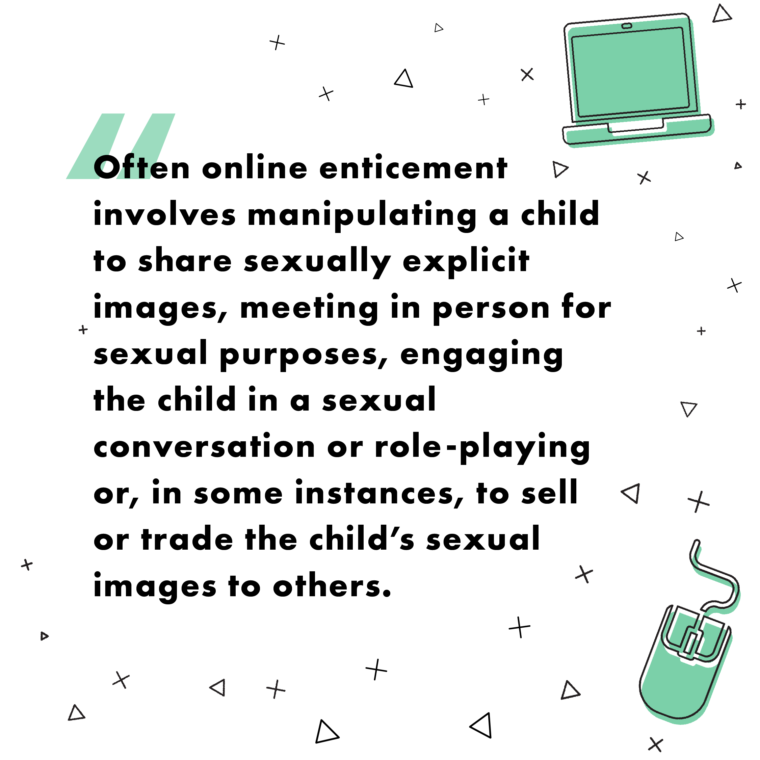Susan Kennedy shares expert advice from the National Center for Missing and Exploited Children about how and why to teach kids body boundaries in the digital age.
Good news first; most kids aren’t being groomed, blackmailed, or otherwise exploited online.
Not-so-great news next; according to a recent report from Thorn, producing, sharing, and re-sharing sexual images is becoming increasingly common and even considered normal among peers. In fact, 1 in 5 girls and 1 in 10 boys between the ages of 13-17 reported having shared nude images of themselves with others.
I’ll be honest, those statistics didn’t really surprise me when I first read them: It’s normal for teens to explore their sexuality – this is just the 21st century version of it. But as I continued to read the report, what did surprise me was this:
Among kids who have shared nudes, 1 in 3 reported sharing nude images with someone they had not met.

It reminded me of an earlier report from the National Center for Missing & Exploited Children on online enticement which found that 98% of reported offenders were people the child had never met in an offline context. Among the most commonly used tactics to acquire sexual content of children were developing a rapport with the child by engaging with their online profiles and offering to exchange or simply asking for sexual images of the child. One child in Thorn’s survey highlighted such an example: “One time this guy asked me, ‘Do you send nudes?’ [online]. I reported it but then Instagram was like, ‘This person has no explicit content on the profile,’ so [Instagram] didn’t take down the page.”
It’s clear that, just as there are offline, there are adults online seeking to sexually exploit children. But here’s some good news: according to the kids in Thorn’s survey, parents and trusted adults play a big role in teaching kids how to behave online. By helping children understand things like body boundaries and consent (both on- and offline) from an early age, we can help them avoid falling for the tricks of would-be offenders as well as foster positive social norms that discourage re-sharing others’ content, which puts them at risk for exploitation and harassment. It’s important that we are thinking about how to connect what we are doing to keep children safe from harm “in real life” to children’s online lives- for example, applying the Darkness to Light’s Five Steps to Protecting Children™ to digital spaces.
I know that talking to kids about technology can feel daunting, especially when the child is savvier on the device/platform than you are! But luckily daily life is full of entry points into safety conversations which may involve tech. For example, after hearing Nanna on speakerphone during a video call, your excited 5-year-old runs downstairs from bath time in just a towel, hoping to talk to her grandparents:
“Can I talk to Nanna!?”
“You can talk to Nanna after you put on pajamas.”
“Why do I have to put on pajamas!?”
“Because under that towel you’re not wearing any clothes, and the parts of your body that are private from other people are also private from pictures and videos and the internet. So, once you’re dressed, you can use the phone to videocall Nanna.”
When we have conversations like this while children are still young, we help them make sense of the limits put in place for technology use and give them a framework within which they can explore and expand their online lives; “I can use this site/game/app, but I don’t do X and Y on it because __________.” This core understanding about digital body boundaries and body safety can help protect children from online exploitation later.
Beyond those natural teachable moments, there are new resources from NCMEC crafted specifically for children ages 10 and under that deal with the topic of explicit online content. Made to compliment the broad internet safety lessons presented in season 1, season 2 of Into the Cloud directly addresses the issue of digital blackmail and inappropriate content. Zion, a young gamer and new friend of Nettie and Webster, finds himself being extorted for 10,000 goldies (game currency) after a user screen grabs a shot of Zion mooning the camera as he goofed off while livestreaming with his gaming friends. The season explores how Zion discloses this information to his father and how he learns to contact the platform to remove his explicit image from their servers. The subject matter, though serious, is addressed in an age-appropriate and relatable manner that children of all ages can understand.
All Into the Cloud resources are free to download. Adults interested in learning more about online exploitation prevention can do so at Missingkids.org/netsmartz/topics, while kids can learn and play on the kid-safe site NetSmartzKids.org.

Susan Kennedy joined the National Center for Missing and Exploited Children in 2018. As the Prevention Program Manager Susan is responsible the implementation of NCMEC’s prevention programs in line with current trends and best practices. Prior to working at NCMEC, Susan worked for nine years at the Center for Alexandria’s Children as the Director of Programs. In that role Susan conducted child forensic interviews, coordinated the Child Advocacy Center program and a community-based prevention program for young children. Susan is an authorized Stewards of Children facilitator. During her time at the Center for Alexandria’s Children she facilitated trainings and coordinated a city-wide training initiative. She has also been fortunate to work and volunteer in a variety of early childhood programs. Susan holds a Bachelor of Science degree in Psychology from The College of William and Mary and a Master of Education degree in Human Development and Psychology from Harvard University.
Follow us on social media to stay up to date and join the conversation.






